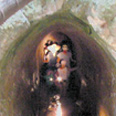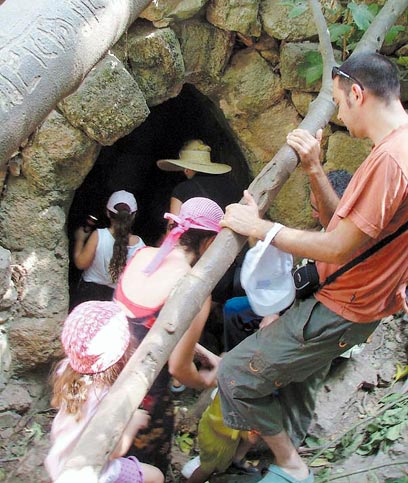
Ein Tanur
צילום: שמעון תמיר
The oven that became a spring
Ein Tanur is incorrectly labeled on many trail maps, but there’s no mistaking the site’s natural beauty
According to legend, Noah’s antediluvian oven stood here before the flood. When God despaired of His creations and destroyed the world, the righteous Noah’s oven began spouting water, thus proving Noah’s great commitment to God.
By the time the deluge was over and the water had subsidized, the oven had forgotten its original purpose. Thus, today, water continues to flow at this site, as if the flood had never ended.
This tale was relayed by Muhammad Abdullah Elhoni, the late mukhtar of Alar, a destroyed village whose overgrown ruins lie on a pastoral mountainside near Moshav Mata. Elhoni claimed that Noah passed by this spot in his ark but saw only a spring rather than his oven. That is why, Elhoni explained, Noah chose to journey on and eventually land on Mount Ararat.

Ein Tanur
Although the spring is appropriately called Ein Tanur (literally, “Oven Spring”), this name does not appear on any trail maps. Many maps erroneously refer to the spring as Ein Mata, and others indicate that the spring is situated several hundred meters from its correct location.
In fact, the real Ein Mata is known as Ein Banat Noach (Arabic for “the spring of Noah’s daughters”). However, nothing can detract from the site’s beauty.
Ein Tanur, which runs along a dirt road coming from Mata on the Zanoach riverbed, is hidden by large eucalyptus trees, which were planted by Arab villagers two or three generations ago.
Tanur also refers to the ruins of a small hamlet lying above the spring. The hamlet was built atop a Crusader farm, which had been fortified against the local Arabs. Several of the remaining structures still display evidence of their Crusader origins.
The six Arab families who lived in this hamlet arrived from Beit-Atav, another fortified village situated on top of the hill adjacent to nearby Moshav Bar Giora. For many years, the residents of Beit-Atav maintained a bitter, ongoing feud with the Alar villagers.
Their quarrels – which pertained to such issues as water use, land and property ownership, animal traffic routes, and much more – were not resolved until the War of Independence. During the so-called “Mountain Operation”, Israeli forces gained control of the area and forced the villagers to cease their feud.
The spring rushes out of a fissure in the granite rock into a small creek which leads into a tangle of assorted weeds and wild plants. An impressive-looking ancient fig tree stands guard at the head of the spring. Many years ago, the venerable tree’s trunk split, and today, six or seven trunks grow from the roots.
Several hundred meters downstream flows the real Ein Mata – the Daughters of Noah Spring – which is just as pretty as Ein Tanur, although its fig tree is somewhat smaller. Ein Mata also emanates from a crevice in a rock, twenty meters deep into the mountainside.
Thick brush surrounds the spring and the irrigation channels which once carried the water to the nearby fields.
During the current winter months, the surrounding hills are green and covered with colorful flowers, including cyclamens, anemones, and even orchids. In addition, the fragrance of wild herbs wafts through the air.
Getting there
Ein Tanur and Ein Mata are only accessible via a dirt road, which is marked both in blue and in the Israel Trail’s colors (Map Number 9: Jerusalem Hills). The road leads from Moshav Mata above the Zanoach River on Route 375, which goes from the Elah Valley to Tzur Hadassah.
From Ein Mata, climb past Hurbat Tanur to the range separating the Zanoach and the Mi’arah Rivers. Descend via the thorny paths to the Mi’arah riverbed.
Once at the river, you’ll observe a relatively wide and comfortable trail, which winds rightward at Maaleh Afik, abuts Ein A-Sufla (Arabic for “the hidden spring”) and ascends towards the Beit-Atav ruins. From there, the path continues on to the Jewish National Fund parking lot in the lovely pine grove near Ness Harim.










